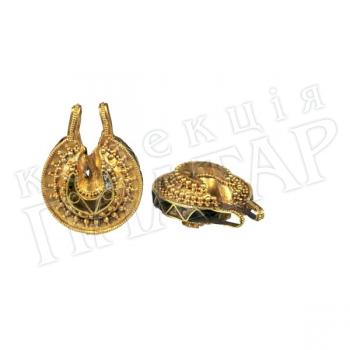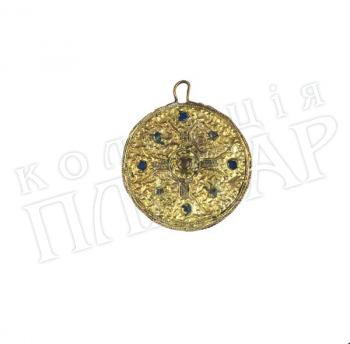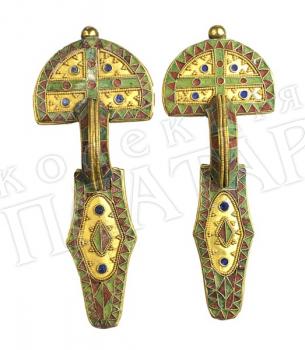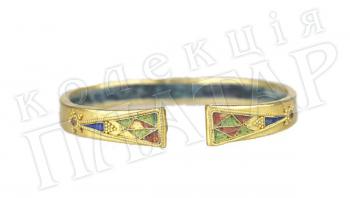Disc-like kolts, hollow, made of two plates, to the ends of which zigzag-like plates forming triangles are soldered, which are filled with paste and glass inserts. Along the contour the kolts are decorated with pseudo-granulation. The front parts of the cutouts near the loops are soldered up with small plates.
The epoch of late Roman Empire and early Byzantine
The period from III century A.D. to VII century A.D. is the time of late Roman Empire and early Byzantine. It was characterized by a highly intense migration process of large and small tribes and nations, resulting in radical change of inhabitants of all territories from Pyrenees to the Ural Mountains during these several centuries. That was the very time, when a modern ethnical map of Europe started to emerge. Not without reason the history of Europe knows the events of the V century as the Great migration of peoples, caused by the invading Europe Hunnes in 375 A.D. And that is the time, when the Slavic warlike tribes of Sclaveenians and Ants, recorded in Byzantine written sources, entered the European historical scene as well. That time showed the geographical and cultural peculiarity of our lands as never before. From the dawn of history these were the territories, witnessing main Eurasian worldviews of ancient times, European barbarism and Asian nomadic culture encountering, interacting and transforming. Part of this chapter’s material deals with the information from the pervious chapter in showing the influence of classic Roman material culture on the barbarian civilization.
The factor that prompted first impulses for European ethnical migration and intermixing was the foreign policy of Roman Empire. The wars against barbarians, who had settled along the Rhine, caused in I century A.D. a vast migration of Germanic tribes from the Northern Europe and Scandinavia into all possible directions, including lands along the Rhine, the Danube and those north of the Black Sea. This process made other European folks to take wing. Soon the entire Europe was on the move. Even the lands north of the Black Sea, and especially the Eastern Crimea and the Bosporus kingdom, experienced the influence of Roman Empire. Even though this region was considered a provincial armpit by the “civilized world” at that time, it played a certain role. The matter is, that already during the rule of Emperor Nero the vector of Roman foreign policy was turned to the East, with him preparing an oriental campaign. His plan was to get across the Caucasus to the Caspian Sea right into the rear of Parthia. Although this plan was not carried out, the role of Bosporus kingdom in Roman oriental policy remained significant for almost two more centuries, mainly because the major Roman army bases along the upper Euphrates being supplied with Bosporus bread through the southern Black Sea province of Pont.
The first Germanic tribes coming down to settle on Ukrainian territories were the so–called Eastern Goths in III century A.D. Alongside with them, such Germanic tribes as Gepeedes, Gerules and Tailafs came to the plains north of the Black Sea as well. Archaeology proved that examining the remains of the Cherniahivska culture of III–V centuries A.D. and sepulchers of Crimean Goths of V–VII centuries A.D. In the middle of III century A.D. the Iranian nomadic folk of Alans settled in the Crimea. The Crimean Alans created a specific material culture, which merged with that of Goths at the beginning of V century A.D., being a proof of some kind of assimilating processes.
The beginning of V century A.D. is characterized by unity of material culture of all barbarian tribes’ elites from the Caucasus to Normandy. This feature is a result of the Hunnes emerging in Europe and the beginning of the Great migration of peoples. Apparently, some jewellery styles (like partiting incrustation) appeared in the Eastern Crimea and later were spread all over the Mediterranean region via the Black Sea.
We can also talk about the material culture of the Slavs during the Roman time. But already at the beginning of Middle Ages and in V–VII centuries A.D. antiquities of the Slavs can be vividly seen both in the lands north of the Black Sea and to the south–west of it, especially along the Danube and in the Balkans. The last decades of the VII century witnessed the nomadic Turkic folk, called Khazary, settling in the steppe zone to the north of the Black Sea and in the Crimea. The invasion of Khazars changed the political situation in the region and starting from VIII century A.D. the succession of nomadic tribes, inhabiting these lands (mainly the Khazars, the Madyars and the Pechenigs), had cut the partially–wooded steppe zones in the north from the Black Sea coast in the south for a long period of time until the Normans came to the lands along the Dnieper.
In the selection the findings belonging to the Roman and Byzantine manufacture are presented by jewelry, including different fibulas, embellishments, metal parts of clothing, and by pottery, ceramics and glass dishes. Some of these items were manufactured especially for trading with the barbarians and these findings were observed only beyond the Empire’s frontiers. Some of these items were of local origin, having been manufactured in ancient and Byzantine centers of the Black Sea region, like Tires, Olvia, Khersones and Bosporus.
The findings belonging to the Germanic tribes include bronze, silver and golden jewelry, pottery, foreign glass chalices and incrusted weapons. The culture of the early medieval Slavs is presented by silver and bronze jewelry. The displays representing nomadic cultures include ceramic dishes, metal details of barbarian and Byzantine belt sets (which were popular among the nomads), fibulas, weapons and so on.












